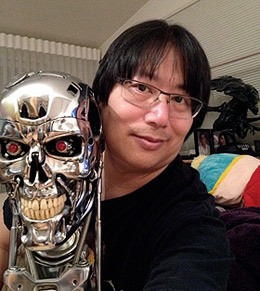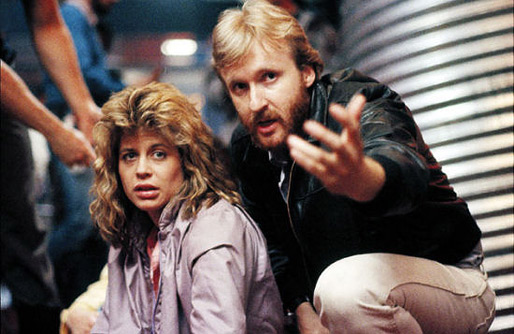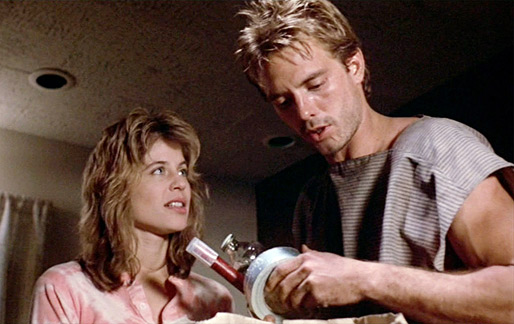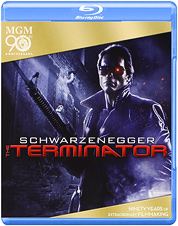For the occasion, The Bits features a Q&A with two Terminator authorities who discuss the virtues of the film, its impact, and its enduring appeal.
Van Ling is a freelance visual effects supervisor, producer, writer, editor, consultant, and digital artist. Van is a summa cum laude graduate of the University of Southern California’s School of Cinema-Television, and he began his film career as a creative/technical/research/VFX assistant to James Cameron on The Abyss, later serving for several years as the head of production for Cameron’s production company, Lightstorm Entertainment. He later formed (with Casey Cannon) the visual effects company Banned from the Ranch Entertainment, where he was involved from 1994 through 1999. Van’s diverse and award-winning career has included producing added-value content for DVD and Blu-ray (and even as far back as LaserDisc), including material found on the discs of The Terminator, Terminator 2: Judgment Day, Field of Dreams, The Abyss, and Titanic. His graphics work can be seen in the Video Essentials calibration disc and in Disney theme park attractions such as Star Tours: The Adventure Continues, the EPCOT Test Track and The Legend of Jack Sparrow. Passengers aboard the Disney Cruise Ships can see his multiscreen animated city panoramas in the Skyline Lounge. His VFX work can be seen in numerous films including The Abyss, Terminator 2, Twister, Starship Troopers, Titanic, and Doctor Dolittle (1998), in trailers for THX and DTS, as well as in DVD & Blu-ray menu design, including those found on the discs for the Star Wars, The Hunger Games, Independence Day, and Terminator 2. Attentive viewers might even spot Van as an actor in Terminator 2, Alien Nation and Titanic. Van is also an active member of the Visual Effect Branch of the Academy of Motion Picture Arts and Sciences, the Producers Guild of America and the Visual Effects Society. He has served six terms on the VES Board of Directors, and is active on the Archives, Vision and Annual Membership Meeting Committees, co-Chairing the latter. His VES 50 Most Influential VFX Films compilation and annual VFX-film montages have been inspiring artists at VES events around the world.
Ian Nathan is the executive editor of Empire magazine and the author of Terminator Vault: The Complete Story Behind the Making of The Terminator and Terminator 2: Judgment Day (Voyageur Press, 2013) and Alien Vault: The Definitive Story of the Making of the Film (Voyageur Press, 2011).


The Bits recently caught up with Van and Ian to discuss The Terminator on the occasion of its 30th anniversary. (The interviews were conducted separately and have been edited into a “roundtable” conversation format.)
Michael Coate (The Digital Bits): In what way is The Terminator worthy of celebration on its 30th anniversary?
Van Ling: I still can’t believe it’s been 30 years! The film has become a touchstone for both the action and science fiction genres, and is still an example of great storytelling and creative filmmaking. And even as the technology advances and the barrier between what’s in a filmmaker’s head and what’s on the screen grows thinner and thinner—and a lot of that technical innovation has been initiated or inspired by Jim Cameron—you can still go back to this one little film and say, it all started with great storytelling and compelling characters. It still holds up after 30 years, and it was the first salvo of an upward trajectory, not only of Cameron’s career but of genre filmmaking, that continues to this day. It blasted through a stereotype wall between what was an “exploitation/genre” picture and what was a “great movie.” One might argue that The Terminator’s DNA is present in almost every film since 1984 that unabashedly combines genre elements, dynamic action, emotion and humor into a satisfying narrative.
Ian Nathan: In simple terms, it is a seminal movie. It invented the career of James Cameron, arguably the most significant director of recent times, certainly the most successful. It defined Arnold Schwarzenegger as an icon, the sublime irony of casting him as a machine. Moreover, despite being made on a micro-budget and designed as a lo-fi science fiction slasher movie, the film remains extraordinary, playful and so influential: everything from The Matrix to The Hunger Games owes it a debt. Sure, it shows its age, and Cameron can’t watch it without wincing, but the propulsive power with which it is made and edited—where the dynamism of the action becomes the plot; story as chase sequence—still hits like a hammer.

Coate: How is The Terminator significant within the science fiction genre?
Ling: I think it proved that you could take a lot of the classic, often-used tropes of the SF genre—time travel, cyborgs, and the nuclear apocalypse among them—and combine them in a way that still takes place in the realistic present-day and is thus relatable to more than just genre fans. It was satisfying as not only an SF movie, but as an action movie, a horror movie, a thriller and a love story. And even as a political commentary if you want to go there. It also followed Ridley Scott’s Alien in presenting a strong female protagonist in an SF genre film, but in some ways a much more relatable one than Ripley, because Sarah started out as a typical “damsel in distress” and then grew into the kickass warrior she is at the end of the film; she’s someone we can relate to who becomes someone we can aspire to. We mostly take this for granted now, but it was kind of a big deal in 1984.
Nathan: As I said, it is massively influential. No Terminator, no T2 and the whole advance of computer effects and dystopian world building. The time travel games have been echoed in Timecop, 12 Monkeys, Looper, et al. The homicidal robot riff was “borrowed” for Robocop, Real Steel and Transformers, et al. As much as Cameron was playing with classic archetypes, he’s was redefining the genre in his own terms: black humor and strong female characters, apocalyptic themes mixed with family values, horror merging into sci-fi. And just that raw power in the film—Cameron’s almost Hitchcockian ability to push the buttons of the audience.

Coate: Van, what was the objective with your documentary film, Other Voices: Creating The Terminator (and why hasn’t it been issued on Blu-ray)?
Ling: It was called Other Voices because we had already done a half-hour featurette with just Jim and Arnold talking to each other for a special VHS boxed set back in 1992, and we were including that piece on a 2000 Special Edition DVD. I wanted to do a more in-depth special feature that covered all aspects of making the movie, and we weren’t originally going to be able to get Jim’s time to participate, so I made sure we interviewed almost everyone else we could find that would speak to us about the film. We were in post on the doc when Jim was suddenly available, and MGM was willing to push the release date of the disc by six months to 2001 to allow me to shoot the interview and completely recut the doc to incorporate Jim’s material. Interestingly, the UK distributor chose to release their DVD in 2000 with the Cameron-less version of my doc, so there’s a lesser “alt” version of the doc available on PAL! As for why it’s not on the Blu-ray, I have no idea. Maybe there is some rights issue or something with MGM. I know they lifted the Music and Visual Effects chapters from my doc and stuck them on the initial Blu-ray release of the film as featurettes.

Coate: Ian, what was the objective with your book, Terminator Vault?
Nathan: Obviously when you tackle classics like the first two Terminator movies, and Alien (with my previous book), you are faced with an immediate dilemma—what is there left to say? My answer was to treat the book as a biography of two films (two parts of one story), to tell the human tales behind the cyborg ones. For me there were three implicit arcs to describe—three creation myths beneath the skin of the making of two great movies. First, it is the story of James Cameron’s unstoppable, quasi-Terminator rise to greatness, whatever the obstacle: from Roger Corman effects, through the debacle of Piranha II, to becoming the most innovative director alive. Second, the rise of Arnold Schwarzenegger to superstardom, and how the first two Terminator films are shaped both by his lack of flexibility (that wonderful mechanical diction) and a genuine subtlety (his movement in both films is sublime). Finally, it is a story about the evolution of special effects from the make-do glories of Roger Corman’s New World Pictures, through model-work and stop-motion, to the epochal arrival of CGI effects. With great access to Cameron, there was so much I never knew.

Coate: Where does The Terminator rank among James Cameron’s films?
Ling: For me, it’s in the top two or three, along with Aliens and either T2 or Titanic. Certainly for the impact they had on me.
Nathan: Simple: third. First: Aliens. Second: Terminator 2: Judgment Day. Third: The Terminator.
Coate: Where does The Terminator rank among the films in the Terminator franchise?
Ling: Tied at the top with Terminator 2: Judgment Day. There is a saying among some fans that “the first two movies are canon, and the rest are just fan fiction.” I can’t say I disagree.
Nathan: This is harder. I do think T2 is more complete a story, and more ambitious—expanding the world, and adding to the emotional core. Still, The Terminator is the slyer beast, a funnier film and a much darker one. And, of course, Arnie as straight up psychotic killing machine is perhaps the more interesting performance. He allowed us to love the bad guy, even as we willed Sarah Connor to escape.
Coate: Can you say a few words about Arnold Schwarzenegger? Is The Terminator the best role he ever had? Why is this character/performance iconic?
Ling: I think Arnold is one smart guy, who not only knows business, performance and marketing, but more importantly in 1984, he knew his strengths and how to use them. Think about it: he was known as a bodybuilder with a thick Austrian accent whose biggest cinematic claim to fame at that point was playing Conan the Barbarian, and he convinced both Jim and Gale, then the studio, and then the whole world, that The Terminator—the title character written as an infiltration unit designed to be unnoticed—should be played by him rather than by the great Lance Henriksen (who fit the original “creepy but ordinary-looking” concept of the character). And this is when he was being put forward by his agents or managers to play the heroic leading man, Kyle Reese… and he pushed back and said, “No, I’d be better for this villain role with no lines instead.” That took guts and brilliance, both from Arnold and from Jim in running with the idea.
Jim and Arnold reshaped the character and repositioned the actor’s brand in a way that took advantage of his strengths and physicality, and turned the character into something really special. He only says a few dozen words in the whole film, he acts like a robot and can only barely portray a human being… and it turns out that his character IS a robot. It subverted any complaints about acting ability by making it work within the story, gave it humor and some self-reflexive awareness but somehow kept the danger and never diminished the character. They took what could have been a ludicrous, over-the-top take on a fantastical character and made it real, with a sense of implacable purpose. You could laugh at the idea, you could call it stunt casting, but you feared the character and you couldn’t take your eyes off of him. He was badass and pragmatic and didn’t care what anyone thought, and was unstoppable in his pursuit of his goal. That kind of fit Arnold’s own nature perfectly, but in real life Arnold adds a level of charm and humor that soon made him a leading man. And I think his subsequent role in T2 was the perfect confluence of the story and character evolving in perfect sync with Arnold’s career trajectory; he was still a badass Terminator but now he was the good guy, and it STILL made perfect sense within and beyond the film itself. But T1 was the start of it, and now, 30 years later, his portrayal of the role is still so iconic that they can’t make a sequel without him if it’s to be considered legit. You have to respect that kind of achievement.
Nathan: It’s easy to dismiss Schwarzenegger’s performance as stunt casting. He certainly changed the tenor of the character from the planned “infiltration unit” Terminator hidden inside Lance Henriksen. Cameron realized he now had comic elements to play with. But there is so much that Schwarzenegger grasped about the role: how he would shoot without blinking, how he could strip a weapon down and reassemble it blindfold, how he would move not jerkily but smoothly, like a “shark,” said Cameron. Talking about the first film there is almost that veil of irony, however inexpressive the T-800 is designed to be. There is this wonderful veneer of irritation that Schwarzenegger gives to the part. The machine is getting exasperated. By the sequel he is adding all these strange, powerful contours—devotion, determination, and, dare we say it, humanity. That’s just it, Cameron’s finest joke: to make us care about a machine.

Coate: Which sound mix of the film do you prefer: the original mono or the multichannel remix?
Ling: A tough question, but I think I lean towards the mono just because it was the original. I was the producer of the initial remix done by the great Gary Rydstrom back in 2000, and while I think he did an excellent job, there is something monolithic yet raw about the original mono mix that fits the film. Also, we found out later that there was a glaring omission in the remix, which was the metallic sounds—almost like that of a sword being drawn from a scabbard—of the letters in the title sliding past each other in the main titles. It turned out that the reason they were missing in the remix was that they were not on either the sound effects or the music masters for the film… they were on the dialogue stems for some reason. And those stems had been muted during the remix since there was no dialogue during the main titles! Lame explanation, but true.
Nathan: I know the arguments, but I love Brad Fiedel’s score too much not to love the multichannel mix more.
Coate: What is the legacy of The Terminator?
Ling: It jumpstarted the careers of many key players in the industry, from Arnold and Gale Anne Hurd to Stan Winston. While some of them had already been working in the business for a while, their work on this particular film really got them noticed and took them to a new, iconic level. But the biggest legacy, of course, is that it introduced the world to Jim Cameron, who himself embodied the very essence of the film and its title character: hard-hitting, dynamic, uncompromising and unstoppable, yet with a surprisingly human heart and emotional core. He and the film proved that below the surface of what was ostensibly a “B”-level exploitation movie could lie a powerful storytelling foundation, and it raised the bar for all genre films. The way the current Marvel films have worked is proof of that legacy, where just because you’re making a genre film doesn’t mean you can’t tell a great story with compelling characters. The Terminator was the kind of film that made you think back in 1984, “Man, if this guy could make THIS on a low budget, imagine what kind of movies he could make with $100 million or even $200 million dollars!” I think we know the answer to that now.
Nathan: Let’s speak in bare terms: it was the film that made James Cameron the most successful and influential director on the planet. It invented the phenomenon of “Arnie”—even in office he couldn’t help but finish a speech with the words, “I’ll. Be. Back.” It also remixed the genre from the glistening purity of Star Wars to a grungier, tougher, amoral polyalloy of sci-fi, horror and realism. But, for me, the proof remains in the watching. Despite its budget (or maybe because of it) 30 years later the film still thrills like no other. “You’re terminated, fucker.”
Coate: Thank you, Van and Ian, for sharing your thoughts on The Terminator on the occasion of the 30th anniversary of its release.
----
- Michael Coate






